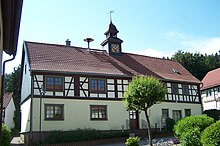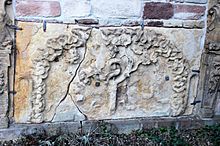Engelsbach
|
Engelsbach
Rural community Georgenthal
Coordinates: 50 ° 50 ′ 53 ″ N , 10 ° 36 ′ 39 ″ E
|
||
|---|---|---|
| Height : | 417 m | |
| Residents : | 258 | |
| Incorporation : | January 1, 1996 | |
| Incorporated into: | Leinatal | |
| Postal code : | 99887 | |
| Area code : | 03623 | |
|
Location of Engelsbach in Thuringia |
||
Engelsbach is a district of the rural community Georgenthal in the district of Gotha in Thuringia.
location
Engelsbach is located about 13 kilometers (as the crow flies) southwest of the district town of Gotha on the northern edge of the Thuringian Forest and about three kilometers east of the town of Friedrichroda . The village is on the federal highway 88 .
history
The place name Engelsbach appears as Egenholdesbach for the first time in 1034. At that time, there was a monastery courtyard in today's settlement area, which was managed by an Egenhold and his clan. The Engelsbacher Mühle is located at the confluence of the Engelsbach in the Leina - the manor house from which it is named could have been located in its vicinity. The village, located in a small side valley west of the mill, was within sight of the Tannenburg , which monitored the ascent of the medieval streets in the area of Schönau in front of the forest and Finsterbergen and was last mentioned in the Thuringian War of Succession. At the mouth of the creek of the same name in the Leina to 1,366 chain to Leinakanal to supply water for Gotha off Gothaer Council therefore once for keeping one of the two sources at Engelbach was required.
The place belonged to this until the dissolution of the Reinhardsbrunn monastery in 1525 and then came to the ruling office of Reinhardsbrunn , which from 1640 to the Duchy of Saxe-Gotha , from 1672 to the Duchy of Saxe-Gotha-Altenburg and from 1826 to the Duchy of Saxe-Coburg and Gotha belonged to.
A major fire ravaged the village in 1769, 25 of the 33 farms and houses had fallen victim to this catastrophe. For the residents of the place, the forestry trades were the most important source of income, mining attempts had already been stopped in the 16th century, the agricultural area was small. Around 1813 the residents also operated linen weaving as a sideline, and trading in house litter in the Gotha area gave a few residents a meager income.
From the middle of the 19th century, Engelsbach acquired a certain importance as the “laundry room” of Thuringia, and the wage laundry that was emerging in the town had a long time standing over industrial steam laundries and ironing establishments thanks to the soft spring water. This service branch was able to stay in place until the 1950s and was used in particular by Gotha and Erfurt textile cleaning companies. Tourism had also become important. For this purpose, an Engelsbach landlord built an excursion restaurant with guest rooms in the center of the village. In the center of the village there is a Christian leisure home that emerged from a former FDGB holiday home.
On July 1, 1950, Engelsbach was incorporated into the community of Finsterbergen . On January 1, 1957, the place broke away from this connection and became an independent municipality again. From 1977 Engelsbach belonged to the Friedrichroda community association. On January 1, 1996, Engelsbach became a district of the community of Leinatal, which became part of the rural community of Georgenthal on December 31, 2019.
Attractions
- In the center of the village one encounters a special feature: the former village school and the small Protestant Christopherus chapel are located as a simultaneous church under one roof. A small roof turret in the middle of the ridge indicates its function as a church. It was 1679 when the Engelsbachers added a first chapel to the existing school building, because the often arduous way to the Johanniskirche on the Alteberg near Altenbergen was 4 km long. Because the construction of the church was not approved by the Gotha Consistory, only afternoon services were permitted. From 1698 baptisms and weddings took place in the church and from 1740 also burials. The current building was erected in 1779, although the church bells probably date from the 14th century and originally hung in the Johanniskirche on the Alteberg. Since 2003 the church has been named after Christopher, the patron saint of car traffic, pilgrims, carters and guardians of accidents. The chapel houses a Knauf organ (around 1845) by Friedrich Christian Knauf. The church belongs to the parish Finsterbergen. ( Location → )
- In 1713, Johann Georg Oschmann from Engelsbach acquired the so-called “Paradiessteine” in Gotha. These are two large-format picture stones from the 16th century, which were walled into Gotha buildings (office building "Haus zum Paradies" ( Schlossberg 12 ) and in the town hall facade), but later no longer corresponded to contemporary tastes and were auctioned off as demolition material. ( Location → )
- The "Thuringian Glass Pearl" is a show workshop for the production of glass jewelry and is located in the eastern part of the village. After the Second World War, around 14,000 displaced persons settled in the Gotha district, many of them from the Gablonz region on the Neisse . Especially around Friedrichroda Ohrdruf small businesses emerged as beside existing there Dolls factories cooperative of Bag makers and Schmuckgürtler and the workshops of the button makers, glass designer and artisan jewelery goods manufacturers .
literature
- Erhard Rosenkranz: Travel Guide Thuringian Forest and peripheral areas . Ed .: Horst H. Müller. Tourist-Verlag, Berlin / Leipzig 1988, ISBN 3-350-00263-3 , Engelsbach, p. 312-314 .
Web links
Individual evidence
- ^ Wolfgang Kahl : First mention of Thuringian cities and villages - A manual . Verlag Rockstuhl, Bad Langensalza 2010, ISBN 978-3-86777-202-0 , p. 69 .
- ↑ Michael Köhler: Thuringian castles and fortified prehistoric and early historical living spaces . Jenzig-Verlag, Jena 2001, ISBN 3-910141-43-9 , Tannenburg, p. 243 .
- ↑ Thuringian Law and Ordinance Gazette No. 11/2019 of October 18, 2019, p. 385 ff. , Accessed on December 30, 2019
- ↑ U. Sareik, S. Ortmann, K. Sturm: Monuments of the Gotha district . Ed .: Council of the District of Gotha. August-Bebel Gotha printing works, Erfurt / Gotha 1987, p. 15 .
- ↑ Helgra Raschke: Expelled: In Gotha caught the Gablonzer to new. Mood of optimism and final decline of the Sudeten German glass and jewelry industry . In: Thuringian General . Gotha 1999.





